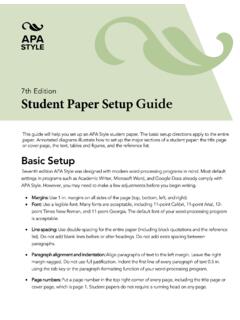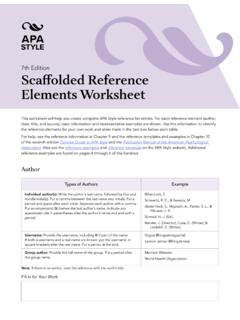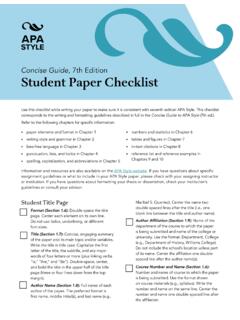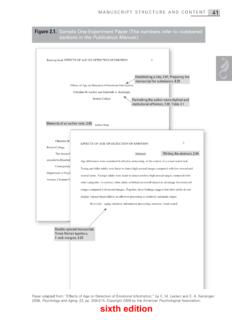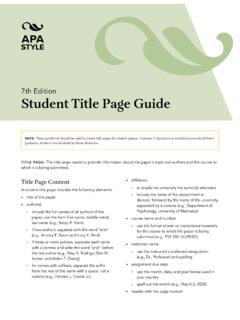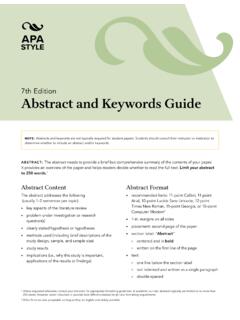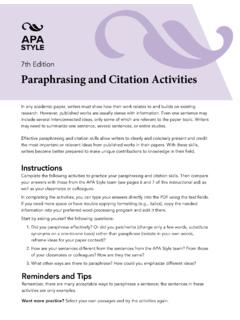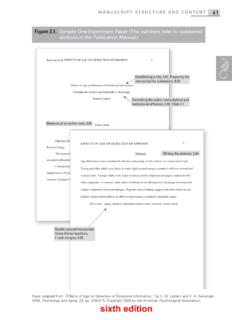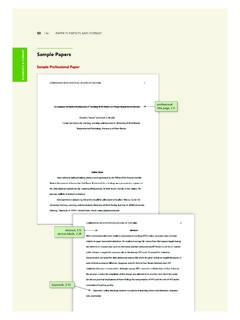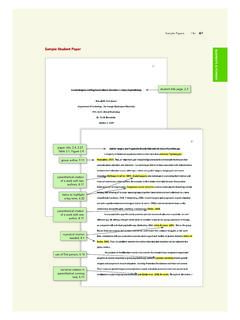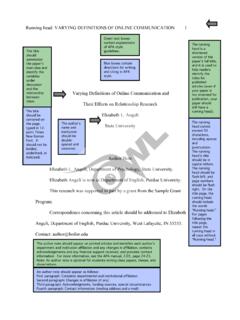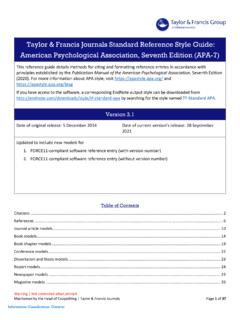Transcription of 7th Edition Avoiding Plagiarism Guide - APA Style
1 7th EditionAvoiding Plagiarism GuideThere are two common types of Plagiarism : (a) improper use of someone else s words and (b) improper use of someone else s ideas. Both forms of Plagiarism involve using someone else s words or ideas without appropriately acknowledging the author or Plagiarism occurs when you use another author s exact words or phrases without quotation marks. Whenever possible, paraphrase sources in yourown words rather than directly quoting helps you to synthesize ideas andintegrate them into the context of your paper.
2 Use direct quotes sparingly and only when it isimportant to reproduce both what was said andhow it was said. If you use an author s words directly, even yourown words from a previous paper, you must usequotation marks (in addition to an in-text citation)to let readers know that these are not youroriginal words. The most blatant form of word Plagiarism occurswhen students copy an author s exact words andknowingly do not use quotation marks or includean in-text citation. A more common type of word Plagiarism is whenstudents think they can use an author s exact (orvery similar words) and include only an in-textcitation.
3 (The citation gives the author credit forthe ideas, but the quotation marks give the authorcredit for the wording of the idea.) If you use an author s exact words, quotation marks and location information must accompany the in-text citation. Another common type of word Plagiarism occurswhen students mistakenly think they haveparaphrased an author s words because theyadded or removed a few words or replaced someof the words with synonyms. This is calledpatchwriting. If your wording has a similarsentence structure and uses the same words andphrases of the original author, you arepatchwriting.
4 (See the example next.) Paraphrasethe idea in your own words passage from Ward et al. (2006): Findingsindicate that media content is not uniformly negative. Information about sexual health, risks, and thoughtful decision-making is sometimes (patchwritten) example: According toWard et al. (2006), media content is not all negative, and information is sometimes present concerning sexual health, risks, and thoughtful Word Plagiarism It is important to paraphrase other authors works inyour own words. When reading a description of an idea or study,it can be hard to represent that idea or finding asclearly and succinctly as the author did withoutplagiarizing.
5 The easiest way to avoid repeatingsentence structure or lifting phrases is to read asection of a work, and then put the work down andwrite notes in your own words. As a general rule, paraphrase when taking notes ona source. Do not write the author s words verbatimwithout putting them in quotation marks andincluding the source location in your notes. Always attribute every idea, fact, or finding you putin your paper when you write Plagiarism occurs when you present an idea from another source without citing the author and year. Any time you write about a concept or idea in apaper without including an in-text citation (or clearlylinking it to a previous sentence containing an in-textcitation), you are claiming the idea as your own (if itis not, that is Plagiarism ).
6 For examples, seeSections and in the seventh editionPublication Manual on appropriate level of citationand long paraphrases. The most blatant form of idea Plagiarism occurswhen students see a good argument or idea in apaper and then represent that argument or idea astheir own. A more common form of idea Plagiarism is whenstudents cite a source incorrectly because theydo not follow proper in-text citation guidelines, asdescribed in Chapter 8 of the Publication example, they may write a whole paragraph about a study and then cite the study s author and year in the last sentence in parentheses, thinking that citation covers the previous sentences.
7 Instead, the in-text citation should appear at the beginning of the paraphrased passage, to establish its origin at the outset. Another common form of idea Plagiarism is whenstudents remember a fact they learned in classand put it in their paper without citing it or whenthey write about a fact they heard somewhere andmistakenly assume it is common Idea Plagiarism To avoid idea Plagiarism , use (a) signal phrases ( , I believe that ) to designate your own idea, or(b) include an in-text citation to a source to signalsomeone else s idea.
8 Most important, always search the literature to find asource for any ideas, facts, or findings that you put inyour paper. See Chapter 8 of the Publication Manual and theIn-Text Citations and Instructional Aids pages of theAPA Style website for more information on creatingin-text citations, integrating source material, andparaphrasing and quoting from a information on Avoiding Plagiarism and self- Plagiarism can be found in Sections and of both the Publication Manual of the american psychological association (7th ed.) and the Concise Guide to APA Style (7th ed.)
9 SOURCE: american psychological association . (2020). Publication manual of the american psychological association (7th ed.). : TRACI GIULIANO, SOUTHWESTERN UNIVERSITYLast updated 11/15/2021
